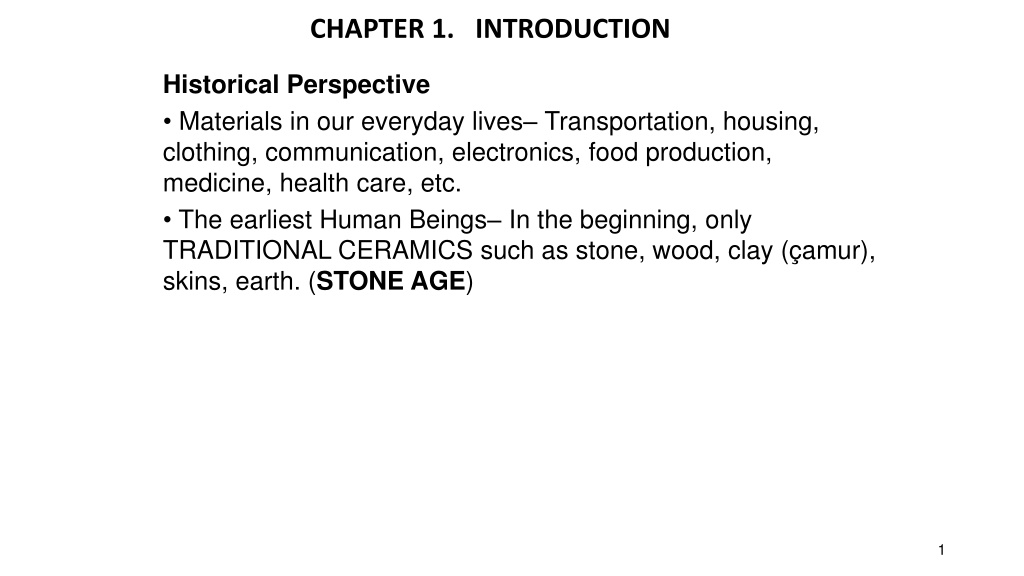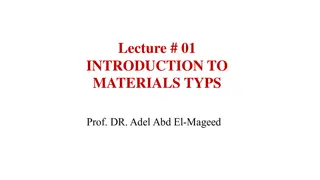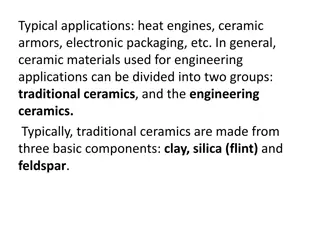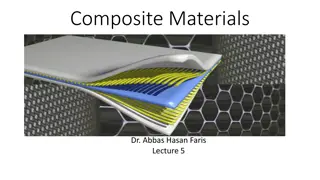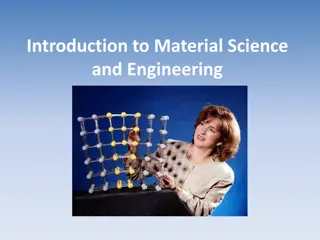Evolution of Materials Science and Engineering in Human History
Explore the journey of materials in human history, from traditional ceramics to high-tech metal industry and beyond. Learn about the development of materials science and engineering, the different properties of materials, and the classification of materials into metals, ceramics, polymers, composites, and semiconductors.
Download Presentation

Please find below an Image/Link to download the presentation.
The content on the website is provided AS IS for your information and personal use only. It may not be sold, licensed, or shared on other websites without obtaining consent from the author. Download presentation by click this link. If you encounter any issues during the download, it is possible that the publisher has removed the file from their server.
E N D
Presentation Transcript
CHAPTER 1. INTRODUCTION Historical Perspective Materials in our everyday lives Transportation, housing, clothing, communication, electronics, food production, medicine, health care, etc. The earliest Human Beings In the beginning, only TRADITIONAL CERAMICS such as stone, wood, clay ( amur), skins, earth. (STONE AGE) 1
CHAPTER 1. INTRODUCTION Historical Perspective - After the creation of the first tools from earth and clay, They discovered METALS, and used metals in the production of useful and powerful tools. (BRONZE AGE) - Since the beginning of 20th century, humans have developed their materials skills to a much greater extent HIGH-TECH METAL INDUSTRY, PLASTICS, GLASSES, FIBERS, COMPOSITES. 2
MATERIALS SCIENCE AND ENGINEERING Materials Science: investigates the relationships between the structures and properties of materials. Materials Engineering: designs or engineers materials on the basis of these structure-property correlations. Structure: the arrangement of internal components of a material. Subatomic structure: represents the electrons and their interactions with the nuclei. Atomic level structure: the organization of atoms or molecules relative to each other. 3
MATERIALS SCIENCE AND ENGINEERING Microscopic structure: the organization of large groups of atoms or molecules that can be seen only with a microscope. Macroscopic structure: its structural elements can be seen with a naked eye. Callister chapter 1-2 syfa 11, 12, 13 ve 14 Property: the value that a material exhibits when subjected to external effect from the environment. SIX DIFFERENT PROPERTIES: Magnetic, Electrical, Thermal, Optical, Mechanical and Chemical Stability Properties 4
Properties Properties are the way the material responds to the environment and external forces. Mechanical properties response to mechanical forces, strength, etc. Electrical and magnetic properties - response electrical and magnetic fields, conductivity, etc. Thermal properties are related to transmission of heat and heat capacity. Optical properties include to absorption, transmission and scattering of light. Chemical stability in contact with the environment - corrosion resistance. 5
CLASSIFICATION OF MATERIALS Solid Materials are grouped into three basic groups based on their chemical structure: 1. METALS 2. CERAMICS 3. POLYMERS In addition to these 3 main material groups- two additional groups exist: these are COMPOSITES AND SEMICONDUCTORS. Metals: composed of metallic elements, they are good conductors, have a polished surface. They are quite strong but also deformable, they are used quite a lot in structural applications. 6
CLASSIFICATION OF MATERIALS Ceramics: They are compounds between metallic and nonmetallic elements. Usually oxides, nitrides, and carbides. Example: Clay, silica, cement, glass, etc. They are good insulators, more resistant to high Temperatures than polymers and metals. They are hard but very brittle. Polymers: plastic and rubber materials. Chemically based on atoms such as Carbon, Hydrogen, Oxygen, Nitrogen. 7
Most of the polymers are organic compounds, but there are also a few inorganic polymers. They have large molecular structures and long chains. Usually they have very high molecular weights between 5.000 gr/mol and 1.000.000 gr/mol. They have low densities and they are very flexible. 8
Composites: mixtures of the main material groups. Polymer- ceramics, polymer-metal, ceramics-metal. For example: embedding of glass fibers into polymers. This polymer-glass fiber composite material has its flexibility from the polymer and its strength from the glass fiber. Semiconductors: They have electrical properties between conductors and insulators. Their conductivity is affected by impurity atoms. They are used in integrated circuitry and revolutionized the electronics and computer industry since 1980s. 9
